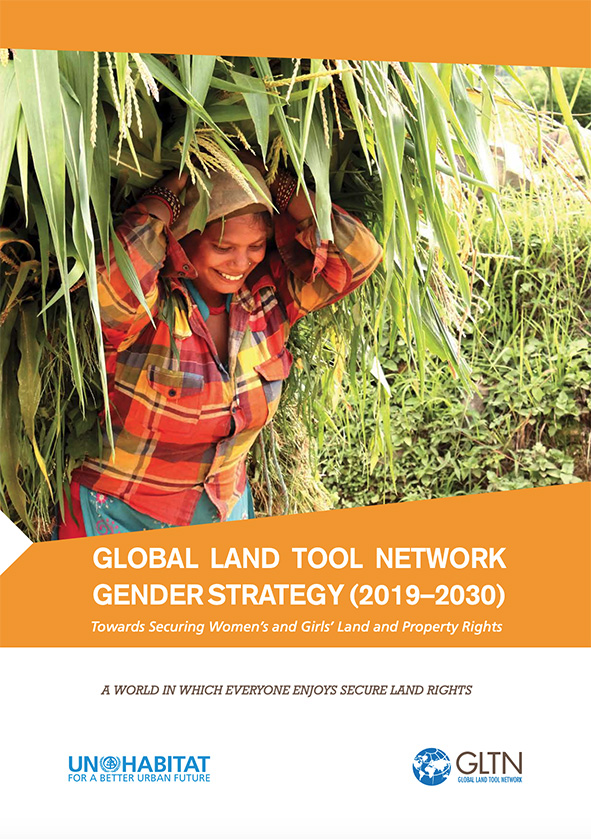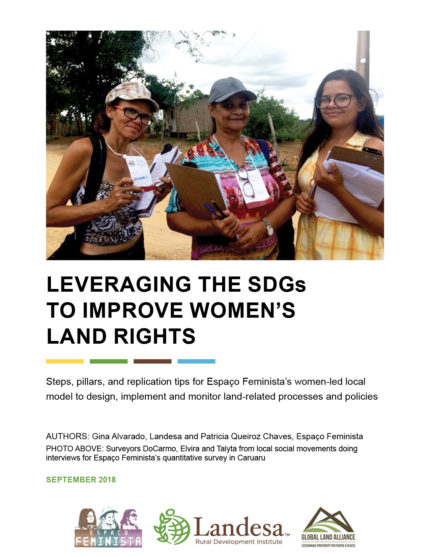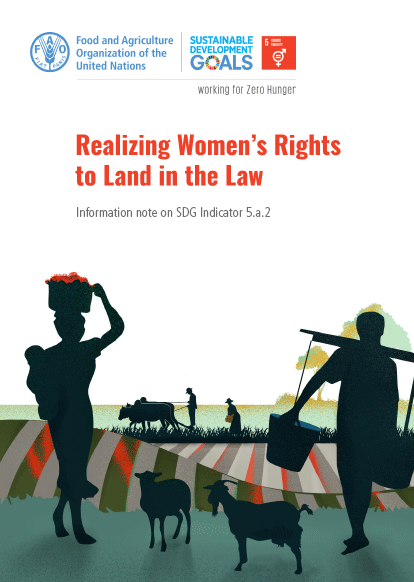
Proportion of countries where the legal framework (including customary law) guarantees women’s equal rights to land ownership and/or control
Last updated on 1 February 2022
This indicator is currently classified as Tier II. The Food and Agriculture Organization of the United Nations (FAO) is the main Custodian agency. UN Women and the World Bank are partner agencies.
Unit of measure: Articles present in primary and/or secondary legislation.
Why is this indicator important?
According to UN Women, "deep legal and legislative changes are needed to ensure women's rights. Stark gender disparities remain in economic and political realms." Discriminatory laws need to be reformed if women and girls are to be empowered with secure, equal rights to land. It will help women and girls achieve power and potential, secure food for their families, generate income, and sustain other livelihood needs. This includes both statutory and customary law. Together with 5.a.1, this indicator encourages countries to review and, where necessary, to strengthen existing policy and legal measures aimed at securing equal rights to land for women and men.
How is the indicator measured and monitored?
SDG indicator 5.a.2 measures the extent to which a country’s legal framework supports women’s ownership and/ or control over land including inheritance rights for women and girls. Progress towards the SDG target will be determined by the extent to which countries have incorporated internationally recognized standards, particularly from the Voluntary Guidelines on Responsible Governance of Tenure (VGGT) and the International Convention on the Elimination of Discrimination against Women (CEDAW), into their legal frameworks. Existing statutory laws are assessed against the six following proxies:
Proxy A: Joint registration of land compulsory or encouraged through economic incentives
Proxy B: Compulsory spousal consent for land transactions
Proxy C: Women’s and girls’ equal inheritance rights
Proxy D: Allocation of financial resources to increase women’s ownership and control over land
Proxy E: In legal systems that recognise customary land tenure, existence of explicit protection of the land rights of women
Proxy F: Mandatory quotas for women’s participation in land management and administration institutions
According to the metadata document, the legal and policy framework encompasses the Constitution, primary and secondary legislation as well as existing policies. Control over land is defined as the ability to make decisions over land, its usage and benefits. In addition to legally acquired land, land ownership in systems where land is owned by the state refers to long-term leases, tenancy, or use rights, to name but a few. The indicator also considers customary legal systems that have been recognised by the state and regulated in national law. It also takes into account the rights of partners in consensual unions when the legal framework recognises such unions.
Data sources include publicly available legal instruments on land (including land registration), family, marriage, inheritance, and gender equality. Only the proxies found in the legally binding primary and secondary legislations are considered in the reporting, but the methodology encourages countries to also review bills, and policies to monitor progress against the 6 proxies. Once the legal assessment is completed, the officially designated national institution(s) responsible for SDG indicators submits a reporting questionnaire to FAO for a quality check, to ensure that the assessment was carried out in accordance with the reporting methodology. Once the process is completed, the national institution officially submits its report to FAO. In 2019 and 2020, 36 countries have reported on this indicator.
As this is one of the few legal indicators in Agenda 2030, one of the key challenges in the reporting lies with the identification of national institutions responsible for SDG indicator 5.a.2. Owing to the nature of this indicator, FAO recommends the nomination of high-level focal points within institutions with a mandate on land, agriculture, justice or gender equality. The responsible institution(s) for SDG indicator 5.a.2 should then nominate a legal expert to carry out the assessment in accordance with the reporting methodology. Another methodological challenge concerns the assessment and computation of heterogenous customary tenure systems.
By Anne Hennings, peer-reviewed by Naomi Kenney, FAO; Martha Osorio, FAO; Everlyne Nairesiae, GLII Coordinator at the Global Land Indicators Initiative (GLII) at GLTN, Un-Habitat and Clinton Omusula, Land Data and Knowledge Management Specialist at the Global Land Indicators Initiative (GLII) at GLTN, UN-Habitat.
Official indicator data
The indicator “measures” the level to which a country’s legal framework supports women’s land rights, by testing it against six proxies drawn from international law and internationally accepted good practices. Currently, data is only available for proxy E: In legal systems that recognise customary land tenure, existence of explicit protection of the land rights of women. It is given on a scale from 1 to 6, where: 1 - there is no evidence of guarantees of gender equality in land ownership and/or control in the legal 6 - highest levels of guarantees of gender equality in land ownership and/or control in the legal framework * Select "year" below to see the most recent data for more countries.
Other related indicators on Land Portal
In addition to the official indicator data, the following indicators provide information concerning women’s tenure security, land rights, and access to land.
Challenges for women’s land tenure in customary law settings: Country Insights Digest #2 - June 2021
Securing women’s land rights remains high in the news and in the development agenda in recent months. A quick search on Land Portal shows since March this year more than 250 resources related to land & gender, including news articles, blogs and publications.
Día Internacional de la Mujer 2021: Luchando por los derechos a la tierra de las mujeres
El tema de este año para el Día Internacional, "Mujeres líderes: Por un futuro igualitario en el mundo de la Covid-19”, celebra los enormes esfuerzos de las mujeres y las niñas de todo el mundo para forjar un futuro más igualitario y recuperarse de la pandemia de la COVID-19. También está en consonancia con el tema prioritario de la 65ª sesión de la Comisión de la Condición Jurídica y Social de la Mujer (CSW65), "Mujeres en la vida pública, participación igualitaria en la toma de decisiones".
Journée internationale de la femme 2021: lutter pour les droits fonciers des femmes
Le thème de cette année pour la Journée internationale, «Les femmes au leadership: Parvenir à un avenir égal dans un monde COVID-19», célèbre les efforts considérables déployés par les femmes et les filles du monde entier pour façonner un avenir plus égal et se remettre de la pandémie COVID-19 . Il est également aligné sur le thème prioritaire de la 65e session de la Commission de la condition de la femme, «Les femmes dans la vie publique, participation égale à la prise de décision».
International Women's Day 2021: Fighting for Women's Land Rights
This year’s theme for the International Day,"Women in leadership: Achieving an equal future in a COVID-19 world", celebrates the tremendous efforts by women and girls around the world in shaping a more equal future and recovery from the COVID-19 pandemic. It is also aligned with the priority theme of the 65th session of the Commission on the Status of Women, "Women in public life, equal participation in decision making."
Paginação
- Page 1
- Next page next ›
Metadata on SDGs Indicator 5.a.2
Indicator 5.a.2: Proportion of countries where the legal framework (including customary law) guarantees women’s equal rights to land ownership and/or control
GLTN Gender Strategy (2019–2030): Towards Securing Women’s and Girls’ Land and Property Rights
The GLTN Gender Strategy (2019-2030) provides a framework for designing land tenure and governance interventions around women’s and girls’ land and property rights. It affirms our commitment and motivates our partners to do more to secure land and property rights for women and girls.
LEVERAGING THE SDGS TO IMPROVE WOMEN’S LAND RIGHTS: MODEL VALIDATION
Steps, pillars, and replication tips for Espaço Feminista’s women-led local model to design, implement and monitor land-related processes and policies.
The Sustainable Development Goals have created an extraordinary window of opportunity to increase the attention to women’s rights and women’s land rights in particular.
Resilience for Sustainable Development in the Lake Chad Basin
The humanitarian crisis in the Lake Chad Basin (LCB) is among the most severe in the world, with more than 10 million people in urgent need of life-saving assistance and protection.
Realizing Women's Rights to Land in the Law
Goal 5 of the Sustainable Development Goals (SDGs) "Achieve gender equality and empoer all women and girls" regonizes the fundamental role of women in achieving poverty reduction, food security and nutrition.
Paginação
![]()

Undertake reforms to give women equal rights to economic resources, as well as access to ownership and control over land and other forms of property, financial services, inheritance and natural resources, in accordance with national laws
Indicator details
The indicator is conceptually clear, has an internationally established methodology and standards are available, but data is not regularly produced by countries.
Key dates:









